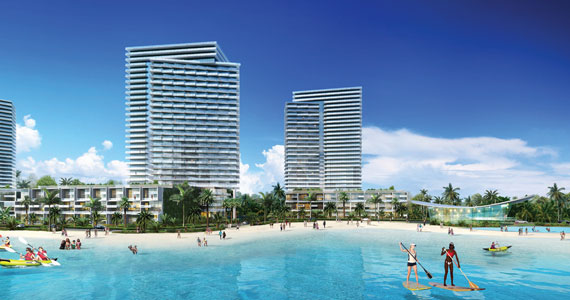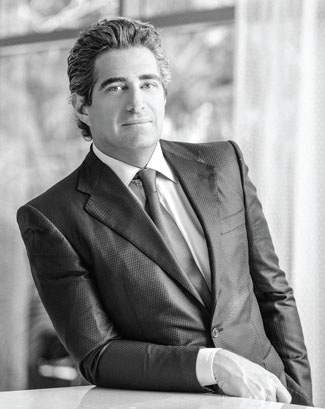In March, shortly after Richard LeFrak bought out former partners Michael Swerdlow and Ezra Katz and brought in Aventura’s Soffer family to develop the 183-acre Biscayne Landing site in North Miami, the billionaire New York developer moved quickly to rechristen the project SoLē Mia, a play on the new owners’ names and Miami.
“I wanted nothing to do with what the other guys did,” LeFrak said during an animated phone interview. “That’s why we don’t use the name.”
Once home to a notorious toxic-waste dump, the massive City of North Miami-owned property at 15045 Biscayne Boulevard has had a long and troubled history, including Superfund site designation in the early 1980s and multiple failed bids for commercial development since 2003.
Last June, when LeFrak and the Soffers broke ground, they unveiled ambitious outlines for a master-planned community. The first phase of construction, scheduled to begin next year, involves building a 400,000- to 500,000-square-foot shopping center that may include a gourmet grocery, a bowling alley, a sporting goods store and restaurants, according to Jackie Soffer, who is overseeing the project with her brother Jeffrey.
Oleta River Partners, the LeFrak-Soffer entity that owns the project, is also proposing a 40,000-square-foot dine-in cinema and 220,000 square feet of office space. To give the commercial development the feel of a real town, an open-air main street will incorporate a fountain and play areas.
SoLē Mia will also include 4,390 high-rise residential units in at least 10 towers, two man-made lagoons, a 150-room hotel, a 100,000-square-foot luxury auto dealership and a 37-acre public park.
The complete project has an estimated cost of $4 billion, and the development team is using equity to fund the initial infrastructure construction, according to a Wall Street Journal article earlier this year.

SoLe Mia would occupy a parcel where development has been stymied since the 1970s.
“It’s a chance to create a brand-new community,” LeFrak told The Real Deal. “If you went to 100 developers with this, 99 would turn the other way because it is too big, too complicated. They don’t have the capital and they don’t have the experience.”
North Miami city leaders are certainly banking on the LeFrak-Soffer dream team to deliver in areas where their predecessors have spectacularly failed. “Both LeFrak and the Soffers have shown they know how to plan and develop communities. I’m just hoping both can build an upscale development for North Miami,” said North Miami Councilwoman Carol Keys.
Her colleague, Councilman Scott Galvin, concurred. “They will get it done,” he said. “I have seen them get down to business very quickly. Previous developers got bogged down in city politics.”
The site is located in a desirable area, stretching from Biscayne Boulevard to Biscayne Bay. Its neighbors include the north campus of Florida International University and the Oleta River State Park. But for more than four decades, the site’s development has been stymied.
In 1972, two years after purchasing some 190 acres from the now-defunct Inter–American Center Authority for $12 million in bonds, North Miami entered into an agreement with a company called Munisport to develop a golf course and tennis courts on the site. The city let Munisport save money by piling up garbage to form hills for the course and avoid paying for sand, according to a 1990 Sun Sentinel article.
But local, state and federal environmental protection agencies ended up citing Munisport from 1976 to 1981 for numerous violations, including accepting hazardous waste and contaminated medical waste. Well after Muni-sport ceased operations in 1983, the U.S. Environmental Protection Agency added the property to its National Priorities List of hazardous waste sites eligible for long-term remedial action funded through the federal Superfund program.
By 1992 the city had entered into an agreement with the EPA requiring North Miami to clean up the site. The EPA removed the Munisport site from the Superfund list seven years later after the EPA finally signed off on North Miami’s plan to remove the contaminated soil.
An environmental cleanup of the site, financed by a $31 million grant from Miami-Dade County, concluded last year. The last truckload of contaminated soil was removed last fall, according to LeFrak. “The site is clean,” LeFrak said. “If it had any issues, I wouldn’t touch it.”
During the previous real estate boom, two condo towers were built there on 7 acres overlooking Biscayne Bay. North Miami had entered into a development agreement with Boca Developers and Swerdlow to construct Biscayne Landing, a community of 4,500 high-end condominiums, a hotel, a town center, schools and parks on the former Superfund site.
In 2006 Boca bought out Swerdlow and reconfigured the plans to resemble a more traditional neighborhood composed of single–family homes and townhouses instead of high-rise condo towers. Saddled with debt when the market crashed, Boca couldn’t finish the project and went out of business by 2010. The property then reverted to the city of North Miami.
The city briefly entertained a proposal that involved building an indoor skiing resort but that deal quickly fell apart amid questions about potential conflicts of interest for North Miami Mayor Andre Pierre: Two principals of the company proposing the resort, Solar Park Management, were close allies of Pierre’s.
In 2011, Swerdlow reentered the picture — this time partnering with LeFrak to form Oleta River Partners — and the city awarded them the site after the only other developer with a proposal dropped out of a competitive bidding process. A year later, Oleta signed a long-term lease, agreeing to pay North Miami $17.5 million, plus $1.5 million in annual rent, $1.7 million in back taxes and $1 million to cover the city’s closing costs. North Miami would also get a small percentage of the gross revenue to be derived from residential sales, a hotel and other commercial activities.
The city amended the deal in October 2014 and agreed to sell 50 acres to Oleta for building condo towers. After forking out $4 million at the outset to the city, Oleta would pay an additional $16 million over 10 years and 3.5 percent in interest. The developer also agreed to give the city 2 percent of the sale of each condo unit.
Then this spring, LeFrak paid out his partners and brought in the Soffers. LeFrak took on the risk of developing the troubled site because it was an “unbelievable opportunity,” he said.
“It’s 180-plus acres in an infill location east of Biscayne Boulevard in a growing city,” LeFrak said. “There is not a piece of property like that anywhere else.”
Mark Gilbert, an executive vice president for Cushman & Wakefield who specializes in retail investment, said LeFrak and the Soffers each have the capability to build communities on their own. But by joining forces, the developers have an even greater chance at success, Gilbert said.
In addition, North Miami and North Miami Beach are primed for a real estate boom, Gilbert said, noting that the Dezer family is planning a large mixed-used project with condos on the Intracoastal Waterway, about 10 blocks north of SoLe Mia.
“The whole area is exploding vertically and that bodes well for them,” Gilbert said. “They are going to provide a product that is not available in Aventura and could possibly pull people from Sunny Isles Beach, Bal Harbour and Bay Harbor Islands.”
To underscore his company’s ability to make SoLe Mia a reality, LeFrak pointed to his 1980s success in Jersey City in developing Newport, a 600-acre neighborhood with eight office buildings, 13 apartment towers, two hotels, a marina, schools, a retail mall and parks. The site resided in an abandoned warehouse district beside a rotting railroad yard along the Hudson River.
“I know what I am doing and I am not motivated by an immediate profit return,” LeFrak said, adding that his development partner, the Soffers’ Turnberry Associates, is no slouch either when it comes to building big. (The Soffers developed much of Aventura and restored the Fountainebleau Miami Beach to its grand luster.)
“I chose a partner that is located five minutes away from the site and that also has experience doing big, long-term developments,” LeFrak said. “The Soffers and the LeFraks have the capital to be patient and the experience doing big things. When I put my name on something, it gets done.”


